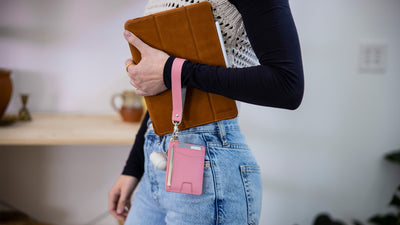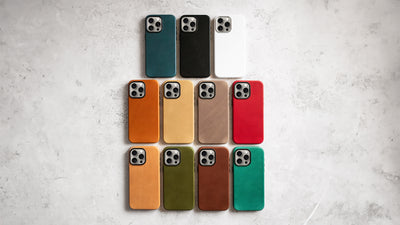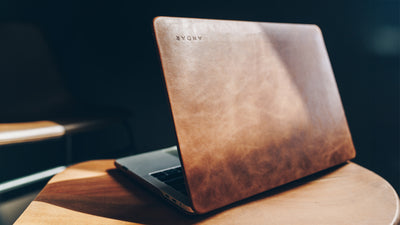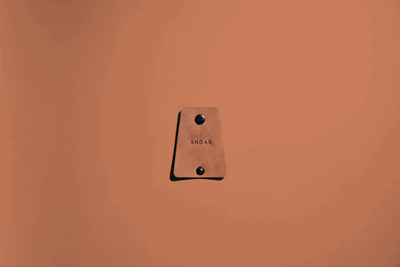The Blog
Can You Use Clorox Wipes on Leather?
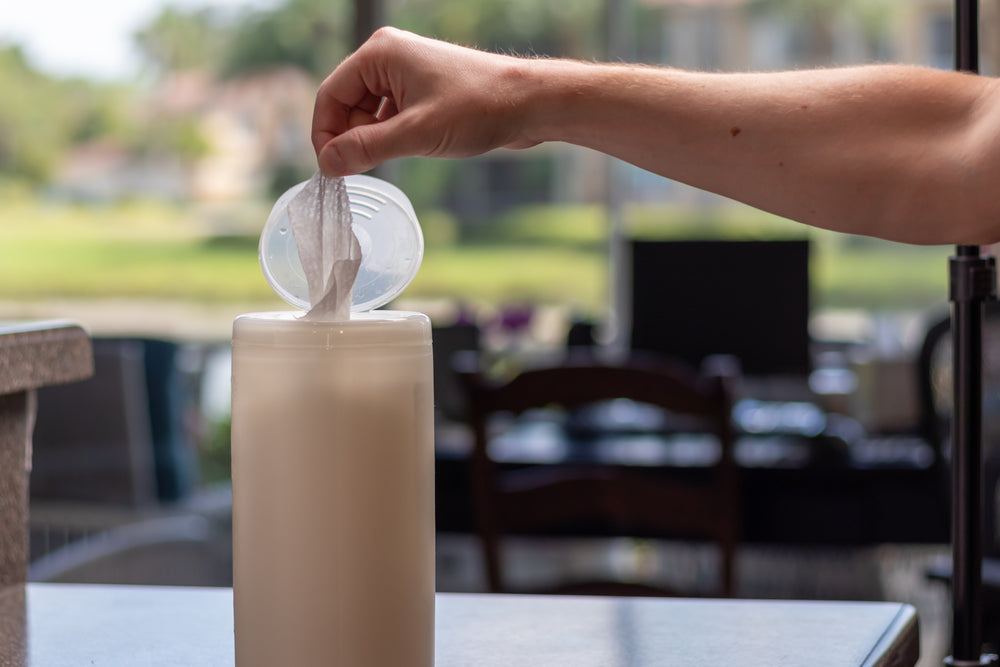
Leather products are known for their timeless appeal, durability, and versatility. However, keeping them clean and well-maintained is crucial for preserving their quality and extending their lifespan.
In our fast-paced world, it's tempting to reach for quick cleaning solutions like Clorox wipes, but are they suitable for cleaning leather? It's important to understand the potential risks that come with such products on delicate materials like leather, especially when considering the high-quality, full-grain, and cactus leather options you love.
In this article, we will explore whether Clorox wipes are safe to use on leather products, discuss proper cleaning techniques, and provide tips on how to maintain the pristine condition of your Andar leather goods.
Understanding Leather: Full-Grain and Cactus Leather
Before we dive into the possible outcomes of using Clorox wipes on leather and talk about tips on proper cleaning techniques, let’s do a quick review of our two favorite types of leather.
Full-Grain Leather
Full-grain leather is the highest quality of leather available. It is made from the strongest part of the hide, with minimal processing, which allows it to retain its natural fibers and characteristics.
This type of leather is highly durable and known for its ability to develop a rich patina over time, adding to its beauty and uniqueness. Since full-grain leather is less processed, it can also better withstand wear and tear, making it an ideal choice for everyday carry items like leather bags and wallets.
Vegan Leather
Cactus leather, on the other hand, is one type of innovative vegan alternative that has gained popularity in recent years. This eco-friendly material is made from the fibers of the Nopal cactus, which is known for its resilience and adaptability.
Cactus leather offers a similar look and feel to traditional leather while being cruelty-free and having a lower environmental impact. It is durable, flexible, and water-resistant, making it a suitable option for those who prefer a more sustainable and animal-friendly alternative to traditional leather products.
The Risks of Using Clorox Wipes on Leather
In order to maintain the quality and longevity of your leather products, it is crucial to understand the potential risks associated with using certain cleaning products, such as Clorox wipes. These disinfectant wipes are often convenient for quick cleaning tasks, but their composition may not be suitable for delicate materials like full-grain and cactus leather.
Harsh Chemicals
Clorox wipes are designed to clean and disinfect various surfaces effectively. They contain a combination of chemicals, including alcohol and bleach, that provide their powerful cleaning properties.
However, these harsh chemicals can be detrimental to delicate materials like leather. Full-grain and cactus leather require gentle care to maintain their natural beauty and durability. Using Clorox wipes on leather can break down the natural fibers, strip away the protective coating, and cause irreparable damage to the material.
Discoloration and Drying
Another potential risk of using Clorox wipes on leather is discoloration. The chemicals found in the wipes can react with the dyes and finish of the leather, causing fading, staining, or an uneven appearance.
Additionally, the alcohol content in Clorox wipes can dry out the leather, leading to cracks and brittleness over time. Leather needs to maintain a certain level of moisture to preserve its suppleness and pliability. Using harsh, alcohol-based cleaning products can disrupt the natural balance of moisture in the material and lead to premature aging.
Reducing the Lifespan of Leather Products
The combination of damage from harsh chemicals, discoloration, and drying can significantly reduce the lifespan of your leather products.
Andar's commitment to creating long-lasting, durable items like bags and wallets hinges on using high-quality materials like full-grain and cactus leather.
However, improper care and cleaning can negate these benefits, causing the leather to deteriorate more quickly than it should. To fully enjoy the advantages of Andar's quality leather goods, it's essential to use appropriate cleaning methods that won't compromise the integrity of the material.
Proper Cleaning Techniques for Leather
Given the potential issue associated with using Clorox wipes on leather, it's crucial to explore alternative cleaning methods that will help maintain the appearance and longevity of your leather items.
Let’s talk about proper cleaning techniques for both full-grain and vegan leather, as well as provide recommendations for suitable leather care products. By following these guidelines, you can ensure that your leather goods will continue to look and perform their best for years to come.
How To Clean Full-Grain Leather
To maintain the quality and longevity of full-grain leather, it is essential to clean it gently and avoid using harsh chemicals. Follow these steps for safe and effective cleaning:
-
Remove loose dirt and debris: Before applying any cleaning solution,
-
use a soft, dry cloth or a soft-bristled brush to gently remove any loose dirt or debris from the surface of the leather.
-
Create a mild cleaning solution: Mix a few drops of a mild, pH-balanced soap or leather cleaner with lukewarm water. Avoid using detergents, bleach, or any other strong cleaning agents that could damage the leather.
-
Test the cleaning solution: Before applying the cleaning solution to the entire item, test it on a small, inconspicuous area of the leather. This will help ensure that the cleaner does not cause discoloration or other adverse effects.
-
Gently clean the leather: Dampen a soft, lint-free cloth with the cleaning solution, and gently wipe the leather in a circular motion. Avoid soaking the leather or scrubbing too hard, as this could cause damage.
-
Dry the leather: After cleaning, use a clean, dry cloth to gently remove any excess moisture from the leather. Allow the item to air dry completely, away from direct sunlight and heat sources, which can cause fading and cracking.
How To Clean Vegan Leather
Vegan leather also requires gentle cleaning methods to maintain its appearance and durability. Follow these guidelines for cleaning vegan leather products:
-
Brush off loose dirt: Use a soft brush to remove any loose dirt or debris from the surface of the vegan leather.
-
Use a damp cloth: For light cleaning, use a soft, damp cloth to gently wipe the surface of the vegan leather. Avoid using any cleaning agents, as they could cause damage or discoloration.
-
Spot clean with mild soap: For tougher stains, mix a few drops of mild, pH-balanced soap with lukewarm water, and use a soft cloth to gently clean the affected area. Rinse the cloth and repeat the process until the stain is removed.
-
Air dry: Allow the vegan leather item to air dry completely, away from direct sunlight and heat sources.
Recommended Products for Leather Care
To help maintain the quality and longevity of your leather items, consider using specialized leather care products, such as:
- Leather cleaners: Look for pH-balanced, non-toxic leather cleaners specifically designed for cleaning full-grain and cactus leather.
- Leather creams conditioners: Regularly applying a leather cream like our Leather Cream can help maintain the moisture balance and suppleness of the leather.
- Leather protectants: Using a leather protectant can help shield your leather items from water, stains, and UV damage.
Maintaining Your Leather Goods
In addition to proper cleaning techniques, here are some everyday care tips you can follow to help maintain the quality of your leather products:
- Avoid overloading: Overstuffing your leather bags or wallets can cause them to stretch and lose their shape. Try to carry only what you need and avoid placing excessive weight on the leather.
- Keep away from heat and sunlight: Prolonged exposure to direct sunlight or heat sources can cause the leather to fade, dry out, or crack. Store your leather goods in a cool, dry place away from direct sunlight.
- Rotate your leather items: Regularly rotating your leather items can help prevent undue stress and wear on specific areas. This practice can help extend the life of your leather products.
- Address spills immediately: If you accidentally spill liquid on your leather item, blot the area with a clean, dry cloth as quickly as possible. Avoid rubbing or applying heat to the affected area, as this can cause further damage.
Wrapping Things Up
In conclusion, while Clorox wipes may be convenient for cleaning many surfaces, they are not suitable for use on delicate materials like leather.
By reviewing the possible issues around using harsh chemicals on leather and following the proper cleaning techniques, you can maintain the quality and longevity of your leather goods. Remember to also practice everyday care tips to ensure your leather items remain in pristine condition.
For more helpful tips and insights on leather care, be sure to visit Andar's article collection and keep your cherished leather products looking their best for years to come.
Sources:
Care of Alum, Vegetable and Mineral-tanned Leather – Canadian Conservation Institute (CCI)
SAFETY DATA SHEET Clorox® Disinfecting Wipes Fresh | Virginia Western Community College

